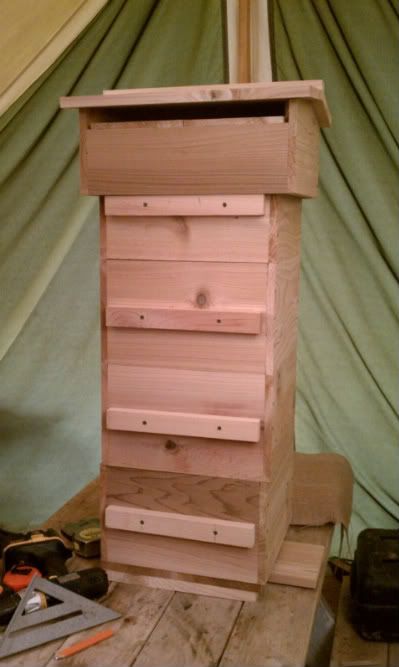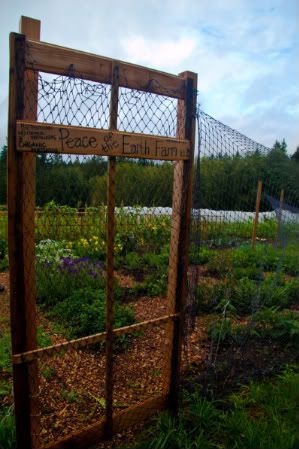Honey bees are used almost exclusively to pollinate some our most important crops and today's agricultural system relies heavily on honey bees and their services. In fact, honey bees are responsible for pollinating 80% of all insect pollinated plants. Honey bees are are often shipped long distances and exposed to many unnatural conditions which could lead to many serious health problems. Many people believe that these stresses have lead to severe decreases in healthy strains of honey bee populations. A healthy honey bee hive should posses strong disease resistance and natural coping skills to deal with pathogens and parasites. However, today's honey bees are often too stressed and weak to fight off pathogens and other threats to hive health. Although no one knows for certain, many believe that these stresses could be a leading contribution to the increased incidence of "Colony Collapse Disorder" (CCD).
Resistant strains that are fully capable of managing their own hive and coping with disease and other issues are hard to come by. Many problems with pathogens and parasites could arise in hives simply because bee strains today are very weak. However, no better time has existed to start strengthening and selecting for strong and resistant honeybees. Natural bee keeping is one way to strengthen and build stronger strains of honey bees.
The main areas of natural beekeeping involve allowing the bees to build a natural comb instead of synthetic comb and eliminating the use of chemical treatments. Natural bee keeping also involves passive observation and reducing the amount of times the bee keeper opens the hive. Many natural bee keepers will only take honey in the spring or when there is an obvious excess in the late summer (or not at all). Feeding the bees should only be done in dire situations and natural sources of feed, such as frames of honey, is recommended. Additionally, switching to a "Warre", "Top Bar" or other natural hive instead of the Langstroth is advisable. Catching swarms, cultivating resistant stock and supporting the cultivation of untreated bees is also a big part of natural bee keeping. And finally, the natural bee keeper is always looking for ways to provide and encourage bee friendly, organic, habitat.
You might be wondering how the natural bee keeper deals with those infamous pests such as mites. Keeping the hive as healthy as possible is the first course of action because a healthy hive is less susceptible to any disease. Additionally, it is important to keep the hive properly vented and include a 1/8" screen bottom. A properly vented hive encourages healthier bees and bees will often clean each other and remove mites. If the hive has a screen bottom, the mites fall through this layer and mites can be significantly reduced in the hive. Also, essential oils such as peppermint and lavender have been shown to repel many pests including mites in bee hives. Lastly, encouraging bees to clean each other regularly by dusting the bees with organic powdered sugar is very important. One bee keeper I know dusts her bees 2 to 3 times a year with powdered sugar to help keep the bees clean and free of mites. Just like with any pest, when the mites are chemically treated, the weakest ones are quickly and easily killed off. The mites that remain to breed are those that are stronger and more resistant to the treatment. Over time, all the mites become resistant to the treatment and this leaves the bee keeper trying out newer chemicals, trying to stay one step ahead of the resistance. This is a process that makes chemical companies very rich often makes pest problems worse. Furthermore, these chemicals could be very dangerous to the bees, the bee keeper, pets, children and anyone else that might come in contact with them. We strongly discourage the use of chemical treatments for mites and encourage bee keepers everywhere to try more natural methods of treatment.
This year we decided to go with a Warre hive for our new package of bees. One of the main benefits of the Warre hive is it allows the bees to build comb from the top down. If bees where building their colony, say in a hollow tree, they would also build their hive form the top down. This helps take advantage of the natural flow of air. Heat rises and helps the keeps air flowing and the bees warmer. Although we were unsuccessful in finding a bee package that came from local and natural sources, we're confident that our bees can thrive in natural conditions hence forth. We'll also be keeping an eye out for swarms in our areas. We've had the bees about two months and they've already filled almost two boxes full of natural comb and are laying brood like crazy. Here are a few pictures of the bee installation and their new hive. We are fairly new to bee keeping and we are very excited to be learning about honey bees on our farm.
Setting the frames in place before installation. You'll notice that we start our frames with just a small strip of organic bees wax. This helps the bees get started but does not control the size of the comb. I've always heard that a synthetic comb helps the bees pull out the comb faster. However, now that I've seen how fast they built these combs, I now know that was a myth. In fact, it seemed like the bees built their own comb faster without the synthetic frame to guide them. Go figure, nature know best, again!
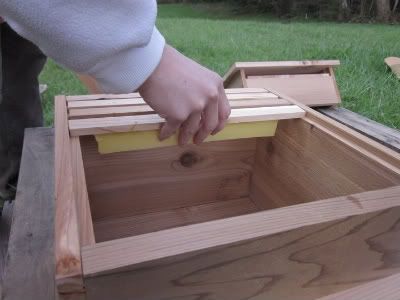
Our bee package, they are so ready to get out of there!!
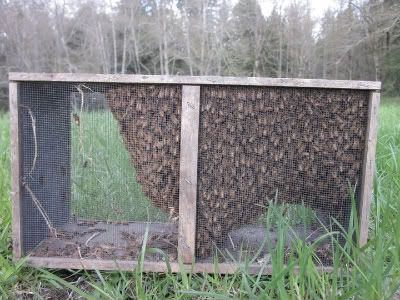
Setting the frames in place, after the installation of the bees:
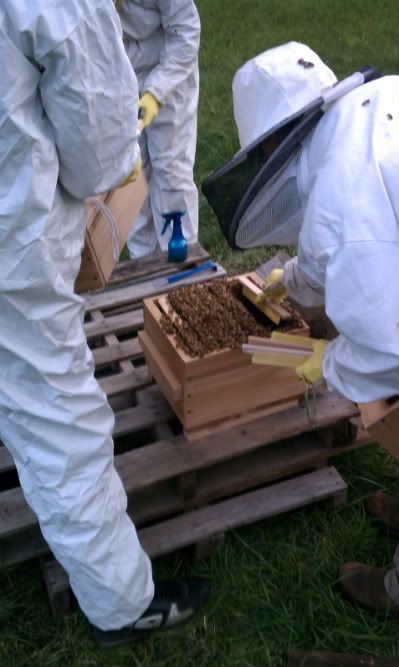
Setting the frames in place before installation. You'll notice that we start our frames with just a small strip of organic bees wax. This helps the bees get started but does not control the size of the comb. I've always heard that a synthetic comb helps the bees pull out the comb faster. However, now that I've seen how fast they built these combs, I now know that was a myth. In fact, it seemed like the bees built their own comb faster without the synthetic frame to guide them. Go figure, nature know best, again!

Our bee package, they are so ready to get out of there!!

Setting the frames in place, after the installation of the bees:

All Done, putting the lid on!

This is the Warre Hive in it's full glory. We started off with just one box and we'll keep adding more boxes on the bottom as the hive grows. If we were going to take honey next spring, we would take the top box off.
